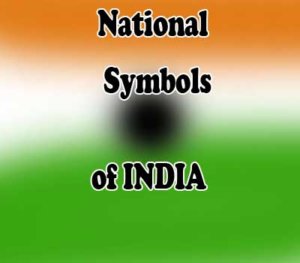National Symbols Of India
Click Here for All Subject Study Materials PDF Download
Banking Awareness PDF Download
- The Republic of India has several official national symbols including a historical document, a flag, an emblem, an anthem, a memorial tower as well as several national heroes.
- All the symbols were picked up at various times. The design of the national flag was officially adopted by the Constituent Assembly just before independence, on the 22nd of July in 1947.
- There are also several other symbols including the national animal, bird, flower, fruit and tree and game.

| S. No | Category | Symbol | Related Persons / Details |
|---|---|---|---|
| 1 | National Flag of India | Horizontal rectangular tricolour of India saffron, white and India green; with the Ashoka Chakra, a 24-spoke wheel, in navy blue at its centre | Our National Flag was designed by Mr. Pingali Venkayya of Andhra Pradesh. It was adopted during a meeting of the Constituent Assembly held on 22 July 1947. |
| 2 | State Emblem of India | An adaptation from the Sarnath Lion Capital of Ashoka | It is preserved in the Varanasi Sarnath Museum in India. the emblem was officially adopted on 26 January 1950. |
| 3 | National Anthem of India | “Jana Gana Mana” | It was composed in Bengali by poet Rabindranath Tagore. was adopted in its Hindi version on 24 January 1950. It was first publicly sung on 27 December 1911 at the Calcutta (now, Kolkata). |
| 4 | National Song of India | “Vande Mataram” | It is a Bengali poem written by Bankim Chandra Chatterjee in 1870s, which he included in his 1881 novel Anandamath. The poem was composed into song by Rabindranath Tagore. The first two verses of the song were adopted as the National Song of India in October 1937 by Congress Working Committee prior to the end of colonial rule in August 1947. After Independence, it was adopted on Jan 24th, 1950. |
| 5 | National Pledge | It was originally written by the Pydimarri Venkata Subba Rao ( an author and a bureaucrat) in Telugu language in 1962. First it was read in the Visakhapatnam in 1963 in a school. Later it was translated to various regional languages accordingly. The practice of reciting it in the schools was introduced in 1965 on 26th of January | |
| 6 | National Currency | Indian Rupee | The Indian rupee symbol is derived from the Devanagari consonant "र" (ra) and the Latin letter "R" was adopted in 2010. Udaya Kumar Dharmalingam born 10 October 1978 in Kallakurichi, Tamil Nadu is the designer of the Indian rupee sign. He is an assistant professor at IIT Guwahati. |
| 7 | National Calendar of India | Calendar based on Saka Era | Usage started officially at 1 Chaitra 1879, Saka Era, or 22 March 1957. Meghnad Saha was the head of the Calendar Reform Committee. The "Day of Silence", is a celebration of the Saka new year in Bali. |
| 8 | National Animal of India | Bengal tiger (Panthera tigris tigris) | Adopted in April, 1973. The largest carnivore is found only in the Indian subcontinent |
| 9 | National River of India | River Ganga | It was declared on November 4, 2008. The Ganga is the longest river of India flowing over 2,510 kms. It originates in the snowfields of the Gangotri Glacier in the Himalayas as the Bhagirathi River. |
| 10 | National Heritage Animal of India | Indian Elephant (Elephas maximus indicus) | Declared on october 22, 2010 by Environment Ministry of India. |
| 11 | National Aquatic Animal of India | Gangetic Dolphin (Platanista gangetica) | Declared on 5th October. Guwahati is the first Indian city to have an animal Mascot as Gangetic river dolphin, It is the first city in India to have a city animal. River dolphin is locally known as Sihu |
| 12 | National Bird of India | Indian peacock (Pavo cristatus) | Declared on February 1, 1963. Indian Peacock or Blue Peacock (Pavo cristatus). |
| 13 | National Tree of India | Indian banyan (Ficus bengalensis) | Adopted on 1950. |
| 14 | National Flower of India | Lotus (Nelumbo nucifera) | It is a sacred flower and occupies a unique position in the art and mythology of ancient India and has been an auspicious symbol of Indian culture since time immemorial. |
| 15 | National Fruit of India | Mango (Mangifera indica) | The great Moghul emperor Akabar had planted about 100,000 mango trees in Lakhi Bagh in Darbhanga. |
| 16 | National Microbe | Lactobacillus delbrueckii subsp. Bulgaricus | It has been announced on October 18, 2012 during the International Conference on ‘Biodiversity Conservation and Education for Sustainable Development held at Hyderabad during CoP-11. The microbe was selected by children who had visited the Science Express Biodiversity Special Train. |
PDF Download
இந்திய தேசிய சின்னங்கள் pdf in tamil download

List of Important Static GK Topics for Competitive Exams
For  WhatsAPP Group – Click Here
WhatsAPP Group – Click Here
Telegram Channel  Click Here
Click Here
from Exams Daily https://ift.tt/2Vdvkhk


No comments:
Post a Comment